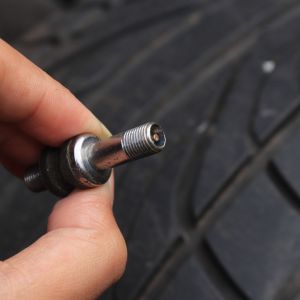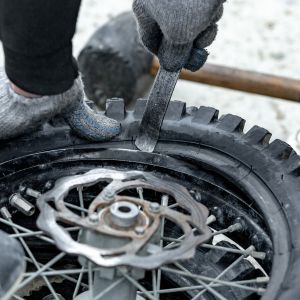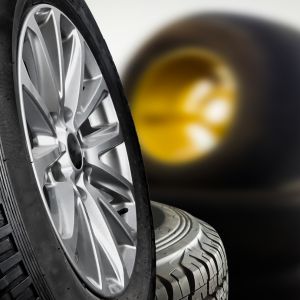Tubeless tyres itself is composed of several different layers. The outer layer, or tread, is made of rubber and is designed to provide traction and durability. The middle layer, or carcass, is made of woven fabric and is designed to provide support for the tread and inner tube. The inner layer, or bead, is made of steel or Kevlar and is designed to hold the tyre securely on the wheel.
Properties of a tubeless tyre

- No Inner tube: The tyre can run without an inner tube because of the airtight seal between the tyre and the wheel.
- Sealant: A liquid that is poured into the tyre before it is mounted on the wheel to create the airtight seal.
- Tread: The outer layer of rubber that provides traction and durability.
- Carcass: The middle layer of woven fabric that provides support for the tread.
- Bead: The inner layer of steel or Kevlar that holds the tyre securely on the wheel.
- Air pressure: The amount of air inside the tyre.
- Tread pattern: The design of the outer rubber layer, which can affect traction and durability.
- Width: The width of the tyre measured in millimetres.
- Durability: The ability of the tyre to withstand wear and tear over time.
- Rolling resistance: The resistance of the tyre to rolling, which affects fuel economy and speed.
Advantages and disadvantages of normal tyre

Advantages of the normal tyre (tubed tyre):
- Widely available and easy to replace.
- Can be repaired easily with a patch or new tube.
- Tubes can be easily swapped out between wheelsets.
- Generally less expensive than tubeless tyres.
Disadvantages of normal tyres:
- Higher risk of punctures, as the tube, can be punctured by sharp objects.
- More maintenance is required, as tubes need to be checked for leaks and air pressure regularly.
- More susceptible to pinch flats, which occur when the tube is pinched between the tyre and the rim.
- Heavier than tubeless tyres.
- Increased rolling resistance due to friction between tube and tyre.
- Can cause more pinch flats because of the need to inflate the tyre to higher pressures to prevent pinch flats, which can result in a harsher ride.
Advantages and disadvantages of tubeless tyre

Advantages of tubeless tyres:
- Lower risk of punctures, as the tyre, is sealed directly to the rim.
- Improved ride quality, as tubeless tyres, can be run at lower pressures without the risk of pinch flats.
- Greater control and stability, as tubeless tyres allow for lower pressure and a larger contact patch with the road.
- Less rolling resistance, as tubeless tyres have a better seal between the tyre and the rim.
- Can be used with sealants that will seal small punctures, which can improve puncture resistance.
- Generally lighter than traditional tubed tyres.
- Better puncture protection as the tubeless tyres can seal small punctures as compared to tube tyres.
Disadvantages of tubeless tyres:
- More difficult to install than traditional tubed tyres.
- More expensive than traditional tubed tyres.
- Can be difficult to repair if a car tyre puncture is too large to be sealed by the sealant.
- Limited availability of certain tyre sizes and models.
- Requires specific rim and tyre compatibility
- More complex to set up and maintain than traditional tubed tyres.
- In case of a serious puncture, tubeless tyres can’t be repaired on the spot and need to be replaced.
Disposal of tubeless tyres
The disposal of tubeless tyres is similar to the disposal of normal tyres. They can be recycled or repurposed for various uses, such as being shredded for use as rubber mulch or ground up for use as a fuel source.
- Recycling: Tubeless tyres can be recycled and used to create new products such as playground surfaces, flooring, and even new tyres.
- Repurposing: Old tubeless tyres can also be repurposed for various uses, such as being used in construction projects or as a barrier to protect against flooding or erosion.
- Incineration: Incineration is an alternative method of disposal, the tyres are burned to generate electricity or used as a fuel source.
- Landfilling: Some tyres are landfilled, but it’s not an environmentally friendly solution as they can take a long time to degrade and release hazardous chemicals.
It is important to note that, Proper disposal of tyres is crucial to reduce the impact on the environment and to avoid potential health hazards. It is always best to check with local recycling centres or waste management facilities to determine the best way to dispose of old tubeless tyres in your area.
Frequently Asked Questions
Q1. What are the disadvantages of tubeless tyres?
Ans: Disadvantages of tubeless tyres include: they can be more difficult to install and repair, as they require a special sealant to create an airtight seal between the tyre and the wheel. They can also be more expensive than normal tyres and not as easy to repair as normal tyres.
Q2. What is the main advantage of tubeless tyres?
Ans: The main advantage of tubeless tyres is that in the event of a puncture, the tyre will not lose all of its air immediately, allowing the rider to continue riding for a short distance until they can repair the tyre. Additionally, a tubeless tyre can be run at lower pressures than a normal tyre without the risk of pinch flats, which can help to improve traction and control.
Q3. Which tyre is better tubeless or with a tube?
Ans: Whether a tubeless tyre or a normal tyre is better for you depends on your specific needs and preferences.
Q4. Can a tubeless tyre burst at high speed?
Ans: It’s possible for a tubeless tyre to burst at high speed, but it’s less likely than a normal tyre because of the sealant that is used to seal any punctures.
Q5. What is the lifespan of the tubeless tyre?
Ans: The lifespan of tubeless tyres is similar to that of normal tyres, depending on the usage and the quality of the tyres.
Q6. Do tubeless tyres reduce mileage?
Ans: Tubeless tyres can provide low rolling resistance which can result in better fuel economy and faster speeds, but it is not guaranteed that it will definitely reduce mileage.
Q7. Do tubeless tyres need maintenance?
Ans: Tubeless tyres require less maintenance than normal tyres, as they do not require the replacement of inner tubes. However, they do require the use of sealant to maintain the airtight seal between the tyre and the wheel.

